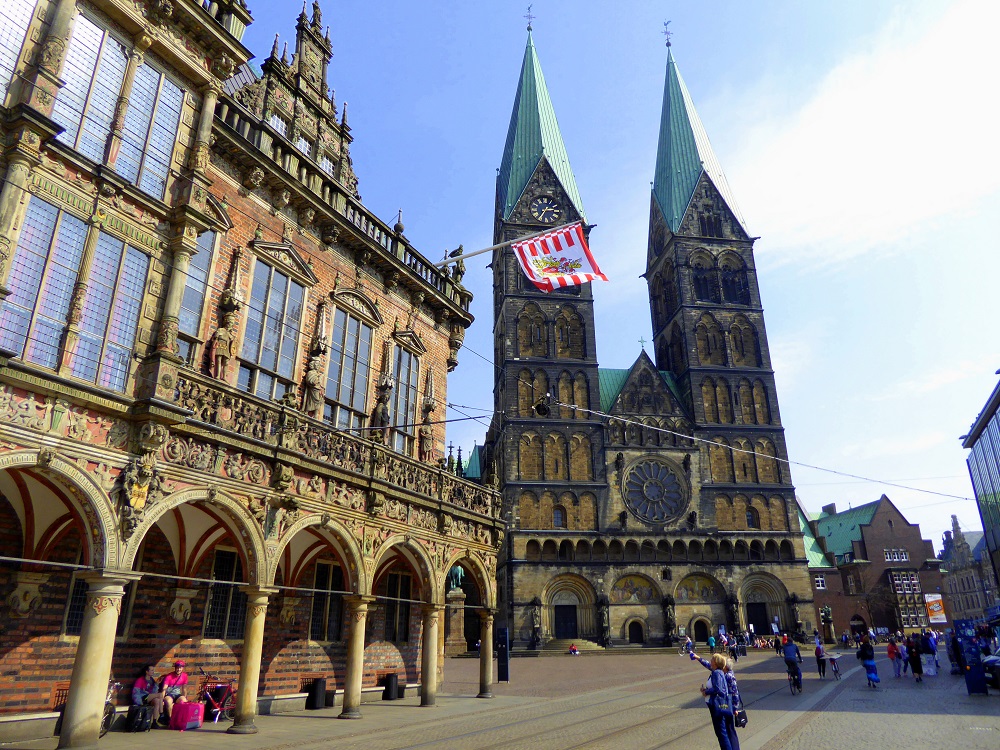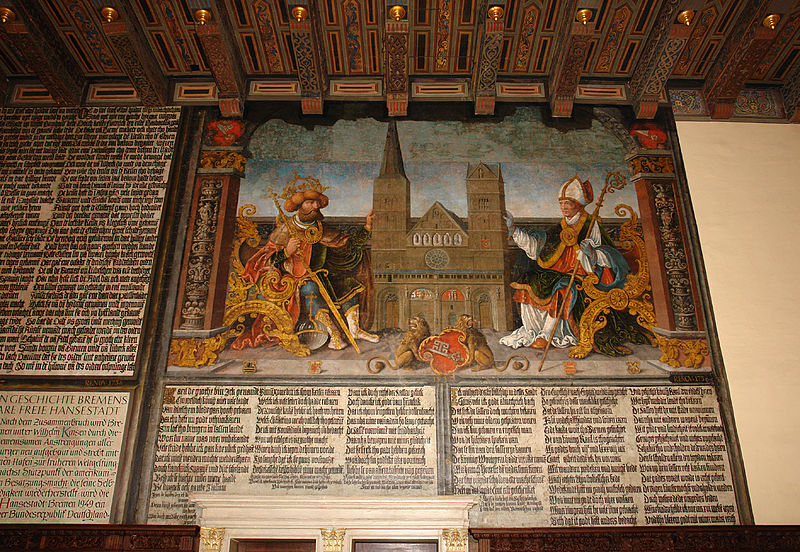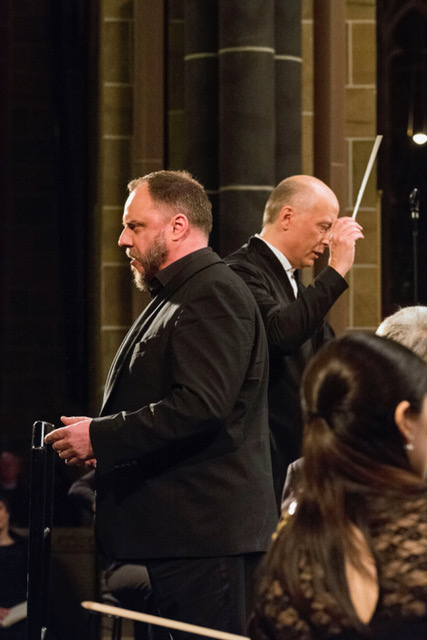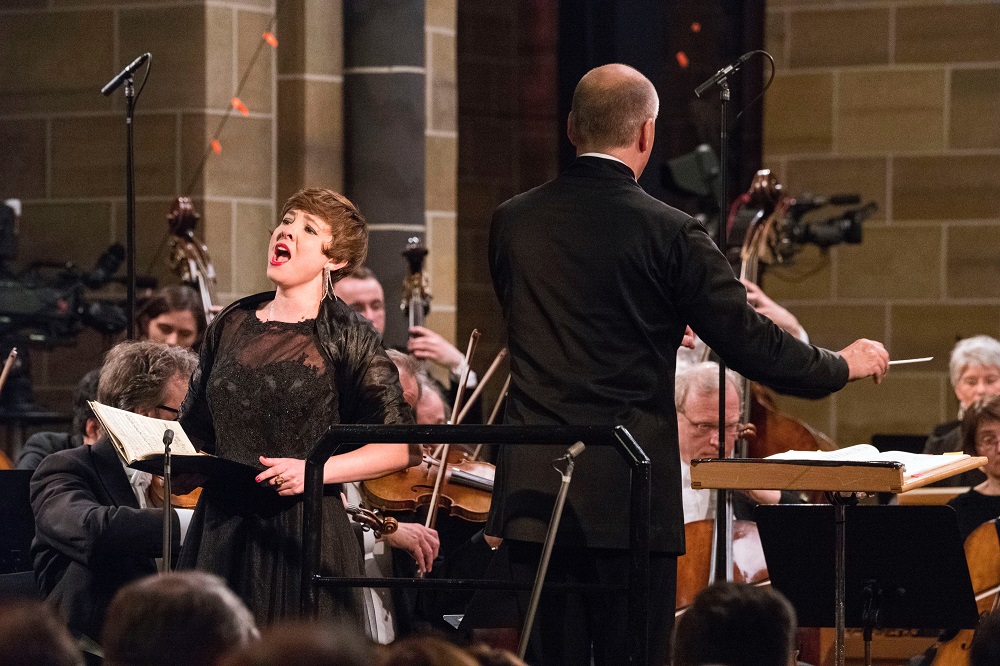theartsdesk in Bremen: 150 years of A German Requiem
theartsdesk.com
David Nice
18.04.2018

They did things differently in 1858. Between the movements of Brahms's surprising new Requiem in the Biblical German of Martin Luther, resounding in Bremen's Romanesque Cathedral on Good Friday, came "Erbarme dich" from Bach's St Matthew Passion, Schumann's "Abendlied" and "I know that my redeemer liveth" from Handel's Messiah. Absent from the Requiem at that time was Brahms's own ineffable movement with soprano soloist. Much as Paavo Järvi and his Deutsche Kammerphilharmonie Bremen liked the idea of resurrecting the original programme 150 years later, to proceed without the "extra" number of Ein Deutsches Requiem would have been like performing Mozart's Don Giovanni in the original Prague version, without Donna Elvira's “Mi tradi,” so they settled on a straight performance of the work as we know it.
Nevertheless this impressively manoeuvred anniversary celebration could only be on the same date, 10 April - albeit not Good Friday, when amateur forces had squeezed in a performance between services - and in the same place: the St Petri Dom. The Dom is one of three remarkable buildings the north side of the Marktplatz, one of the most beautiful German squares. There's also the rival people’s hall church of Our Lady and, in between, the greatest architectural glory of the three, the Rathaus of 1405-10 with its extraordinarily rich facade. That was completed in 1612 in what is known as "Weser Renaissance" (after the river which brought Bremen its prosperity as a member of the Hanseatic League). The idea was to outstrip the Renaissance splendour of the merchant’s hall, the Schütting, on the square’s south side. It succeeded. In the bombing of World War Two which destroyed 60 percent of the city's buildings, the Rathaus was somehow spared along with the gigantic 1404 stone statue of Charlemagne's nephew Roland, champion of the Bremen townsfolk. Both the statue and the Rathaus have UNESCO world heritage status, and Bremen remains a free city-state like Hamburg and Berlin, with senators rather than cabinet ministers sitting in the State Parliament on the main square. Given that the Marktplatz has buildings from so many centuries jostling for attention, it seems a bit churlish to object to the design of Wassili Luckhardt, completed in 1966, which combines symbolic glass transparency with a reflection of the Rathaus’s design. At least this is a square still working with the same purpose for which it was designed.
In the bombing of World War Two which destroyed 60 percent of the city's buildings, the Rathaus was somehow spared along with the gigantic 1404 stone statue of Charlemagne's nephew Roland, champion of the Bremen townsfolk. Both the statue and the Rathaus have UNESCO world heritage status, and Bremen remains a free city-state like Hamburg and Berlin, with senators rather than cabinet ministers sitting in the State Parliament on the main square. Given that the Marktplatz has buildings from so many centuries jostling for attention, it seems a bit churlish to object to the design of Wassili Luckhardt, completed in 1966, which combines symbolic glass transparency with a reflection of the Rathaus’s design. At least this is a square still working with the same purpose for which it was designed.
The one interior that has to be seen is the main hall of the Rathaus, on the first floor above the wooden-beamed Gothic former market and assembly hall. Model trading ships hang from the ceiling; a whale and large fish are featured among the paintings high on the walls, which also include a fresco featuring the Cathedral between Emperor and Archbishop dating from 1532 (pictured below). The Güldenkammer within the hall extends the glory of the Weser Renaissance façade. While on my visit receptions before and after were held in first floor rooms, it was to the secret space in the Ratskeller that Brahms, Clara Schumann and other leading lights of German music came after the premiere of A German Requiem. Bacchus has been vital to Bremen ever since the Church granted monopoly of the wine trade to Bremen in 1405, and the great German wines came travelling northwards along the country’s longest river. Redolent with the port-like aromatic fumes released from the giant caskets, it has an air of mystery, and the Rosicrucian symbol painted on the ceiling. The oldest barrel of wine in Germany, dating from 1653, has pride of place at a kind of altar in a mysterious setting entirely lit by candlelight. Town councillors came here to exchange words which could never be spoken anywhere else. The biggest privilege, though, was to hear an orchestra of about the size Brahms conducted in 1868 in more or less the same impressive Romanesque interior the composer from nearby Hamburg knew and loved. Subsequent remodelling after 1858 meant, for instance, that you would never get chorus and orchestra in the current organ gallery, as they were at the first performance. For Järvi, taking on the same acoustics was always going to be a leap of faith. Most of us have experienced German Requiems in a sharper concert-hall environment, where the demands of Luther's fiery, consonant-spitting text on both choir and soloists can yield surprisingly operatic results.
The biggest privilege, though, was to hear an orchestra of about the size Brahms conducted in 1868 in more or less the same impressive Romanesque interior the composer from nearby Hamburg knew and loved. Subsequent remodelling after 1858 meant, for instance, that you would never get chorus and orchestra in the current organ gallery, as they were at the first performance. For Järvi, taking on the same acoustics was always going to be a leap of faith. Most of us have experienced German Requiems in a sharper concert-hall environment, where the demands of Luther's fiery, consonant-spitting text on both choir and soloists can yield surprisingly operatic results.
It was noble, in this centenary year of the Baltic states, for the Deutsche Kammerphilharmonie's Estonian conductor to choose 60 stalwart voices from Riga, the Latvian State Choir. They could, of course, have been coached to a high level of German delivery. But that didn’t seem to have been the aim of their chorus master; and then the eldest of the two Järvi sons, unlike their father Neeme, doesn’t have much experience of opera.

David Nice
18.04.2018
Paavo Järvi conducts Brahms's dramatic masterpiece in its original cathedral location

They did things differently in 1858. Between the movements of Brahms's surprising new Requiem in the Biblical German of Martin Luther, resounding in Bremen's Romanesque Cathedral on Good Friday, came "Erbarme dich" from Bach's St Matthew Passion, Schumann's "Abendlied" and "I know that my redeemer liveth" from Handel's Messiah. Absent from the Requiem at that time was Brahms's own ineffable movement with soprano soloist. Much as Paavo Järvi and his Deutsche Kammerphilharmonie Bremen liked the idea of resurrecting the original programme 150 years later, to proceed without the "extra" number of Ein Deutsches Requiem would have been like performing Mozart's Don Giovanni in the original Prague version, without Donna Elvira's “Mi tradi,” so they settled on a straight performance of the work as we know it.
Nevertheless this impressively manoeuvred anniversary celebration could only be on the same date, 10 April - albeit not Good Friday, when amateur forces had squeezed in a performance between services - and in the same place: the St Petri Dom. The Dom is one of three remarkable buildings the north side of the Marktplatz, one of the most beautiful German squares. There's also the rival people’s hall church of Our Lady and, in between, the greatest architectural glory of the three, the Rathaus of 1405-10 with its extraordinarily rich facade. That was completed in 1612 in what is known as "Weser Renaissance" (after the river which brought Bremen its prosperity as a member of the Hanseatic League). The idea was to outstrip the Renaissance splendour of the merchant’s hall, the Schütting, on the square’s south side. It succeeded.
 In the bombing of World War Two which destroyed 60 percent of the city's buildings, the Rathaus was somehow spared along with the gigantic 1404 stone statue of Charlemagne's nephew Roland, champion of the Bremen townsfolk. Both the statue and the Rathaus have UNESCO world heritage status, and Bremen remains a free city-state like Hamburg and Berlin, with senators rather than cabinet ministers sitting in the State Parliament on the main square. Given that the Marktplatz has buildings from so many centuries jostling for attention, it seems a bit churlish to object to the design of Wassili Luckhardt, completed in 1966, which combines symbolic glass transparency with a reflection of the Rathaus’s design. At least this is a square still working with the same purpose for which it was designed.
In the bombing of World War Two which destroyed 60 percent of the city's buildings, the Rathaus was somehow spared along with the gigantic 1404 stone statue of Charlemagne's nephew Roland, champion of the Bremen townsfolk. Both the statue and the Rathaus have UNESCO world heritage status, and Bremen remains a free city-state like Hamburg and Berlin, with senators rather than cabinet ministers sitting in the State Parliament on the main square. Given that the Marktplatz has buildings from so many centuries jostling for attention, it seems a bit churlish to object to the design of Wassili Luckhardt, completed in 1966, which combines symbolic glass transparency with a reflection of the Rathaus’s design. At least this is a square still working with the same purpose for which it was designed.The one interior that has to be seen is the main hall of the Rathaus, on the first floor above the wooden-beamed Gothic former market and assembly hall. Model trading ships hang from the ceiling; a whale and large fish are featured among the paintings high on the walls, which also include a fresco featuring the Cathedral between Emperor and Archbishop dating from 1532 (pictured below). The Güldenkammer within the hall extends the glory of the Weser Renaissance façade. While on my visit receptions before and after were held in first floor rooms, it was to the secret space in the Ratskeller that Brahms, Clara Schumann and other leading lights of German music came after the premiere of A German Requiem. Bacchus has been vital to Bremen ever since the Church granted monopoly of the wine trade to Bremen in 1405, and the great German wines came travelling northwards along the country’s longest river. Redolent with the port-like aromatic fumes released from the giant caskets, it has an air of mystery, and the Rosicrucian symbol painted on the ceiling. The oldest barrel of wine in Germany, dating from 1653, has pride of place at a kind of altar in a mysterious setting entirely lit by candlelight. Town councillors came here to exchange words which could never be spoken anywhere else.
 The biggest privilege, though, was to hear an orchestra of about the size Brahms conducted in 1868 in more or less the same impressive Romanesque interior the composer from nearby Hamburg knew and loved. Subsequent remodelling after 1858 meant, for instance, that you would never get chorus and orchestra in the current organ gallery, as they were at the first performance. For Järvi, taking on the same acoustics was always going to be a leap of faith. Most of us have experienced German Requiems in a sharper concert-hall environment, where the demands of Luther's fiery, consonant-spitting text on both choir and soloists can yield surprisingly operatic results.
The biggest privilege, though, was to hear an orchestra of about the size Brahms conducted in 1868 in more or less the same impressive Romanesque interior the composer from nearby Hamburg knew and loved. Subsequent remodelling after 1858 meant, for instance, that you would never get chorus and orchestra in the current organ gallery, as they were at the first performance. For Järvi, taking on the same acoustics was always going to be a leap of faith. Most of us have experienced German Requiems in a sharper concert-hall environment, where the demands of Luther's fiery, consonant-spitting text on both choir and soloists can yield surprisingly operatic results.It was noble, in this centenary year of the Baltic states, for the Deutsche Kammerphilharmonie's Estonian conductor to choose 60 stalwart voices from Riga, the Latvian State Choir. They could, of course, have been coached to a high level of German delivery. But that didn’t seem to have been the aim of their chorus master; and then the eldest of the two Järvi sons, unlike their father Neeme, doesn’t have much experience of opera.

From a conductor who’s won high drama in the great symphonies from the Philharmonia and his remarkable Estonian Festival Orchestra, there was little attempt to get the choristers to project the meanings, little direct verbal communication between conductor and choir. And having witnessed an electrifying theatricality from the last two choruses I’d heard in the work, those of the Royal Opera and English National Opera, the accurate but neutral singing was something of a disappointment.
Not so the very different projection of the two soloists. Matthias Goerne (pictured rightwith Järvi and the other performers), whom I last saw as a Wotan with his head in the score against an otherwise very dramatic team in Jurowski’s concert staging of Wagner’s Das Rheingold, was on top form, hands free to express the Old Testament figure he cut in a text he set on fire, the voice this time free and resonant throughout the range.
Romanian soprano Valentina Farcas (pictured below) had that same evenness, and something even more rare in what has to come over as a deceptively easy and ethereal sound – textural clarity in the upper register. Her fusion with the ineffable Bremen woodwind in the dying fall of her movement was a truly magical moment which the acoustics couldn’t muddy. No doubt there was much inner clarity going on within the orchestra, but you simply couldn’t hear much of it. At least Järvi kept the music on the move; no one wants a stodgy German Requiem, of which there have been plenty failing Brahms in his expressive objectives. Here the interest was held throughout. Though the circumstances provided some of the necessary emotion, then, it was difficult to get a clear picture of Järvi’s interpretation. That it offered food for thought on how to approach Brahms in a week which also entailed mulling over conductor Robin Ticciati’s arguments for the power of word and idea in the composer’s music, the supposedly abstract symphonies included, only added to the non-stop dialogue we all need to have with this most complex and at times elusive of composers. Järvi’s post-concert feeling was that in future he only wants to conduct Ein Deutsches Requiem in an ecclesiastical setting; mine would be that I can’t wait to hear it again in a concert hall with superb acoustics.
Though the circumstances provided some of the necessary emotion, then, it was difficult to get a clear picture of Järvi’s interpretation. That it offered food for thought on how to approach Brahms in a week which also entailed mulling over conductor Robin Ticciati’s arguments for the power of word and idea in the composer’s music, the supposedly abstract symphonies included, only added to the non-stop dialogue we all need to have with this most complex and at times elusive of composers. Järvi’s post-concert feeling was that in future he only wants to conduct Ein Deutsches Requiem in an ecclesiastical setting; mine would be that I can’t wait to hear it again in a concert hall with superb acoustics.
I do, though, want to encounter this superlative orchestra again in its revelatory home town, which has the equal riches of the Paula Modersohn-Becker and Roselius-Haus Museums in the 1920s half-Expressionist re-design of Böttcherstraße south of the Marktplatz. Oh, and what about the squally old donkey, cat, dog and rooster of the Grimm fairy tale who’ve led Bremen to be dubbed “the town of the Town Musicians”? Though there’s a splendid statue to them on the Keller-entrance side of the Rathaus by Bauhaus sculptor Gerhard Marcks, erected in 1951, unlike Brahms, these not-so-serious singers never got as far as the centre, settling down instead to enjoy the forest home of the robbers they’d frightened away with their din. In any case, perhaps Bremen was always too good a musicians' city to host them.
https://theartsdesk.com/classical-music/theartsdesk-bremen-150-years-german-requiem
Not so the very different projection of the two soloists. Matthias Goerne (pictured rightwith Järvi and the other performers), whom I last saw as a Wotan with his head in the score against an otherwise very dramatic team in Jurowski’s concert staging of Wagner’s Das Rheingold, was on top form, hands free to express the Old Testament figure he cut in a text he set on fire, the voice this time free and resonant throughout the range.
Romanian soprano Valentina Farcas (pictured below) had that same evenness, and something even more rare in what has to come over as a deceptively easy and ethereal sound – textural clarity in the upper register. Her fusion with the ineffable Bremen woodwind in the dying fall of her movement was a truly magical moment which the acoustics couldn’t muddy. No doubt there was much inner clarity going on within the orchestra, but you simply couldn’t hear much of it. At least Järvi kept the music on the move; no one wants a stodgy German Requiem, of which there have been plenty failing Brahms in his expressive objectives. Here the interest was held throughout.
 Though the circumstances provided some of the necessary emotion, then, it was difficult to get a clear picture of Järvi’s interpretation. That it offered food for thought on how to approach Brahms in a week which also entailed mulling over conductor Robin Ticciati’s arguments for the power of word and idea in the composer’s music, the supposedly abstract symphonies included, only added to the non-stop dialogue we all need to have with this most complex and at times elusive of composers. Järvi’s post-concert feeling was that in future he only wants to conduct Ein Deutsches Requiem in an ecclesiastical setting; mine would be that I can’t wait to hear it again in a concert hall with superb acoustics.
Though the circumstances provided some of the necessary emotion, then, it was difficult to get a clear picture of Järvi’s interpretation. That it offered food for thought on how to approach Brahms in a week which also entailed mulling over conductor Robin Ticciati’s arguments for the power of word and idea in the composer’s music, the supposedly abstract symphonies included, only added to the non-stop dialogue we all need to have with this most complex and at times elusive of composers. Järvi’s post-concert feeling was that in future he only wants to conduct Ein Deutsches Requiem in an ecclesiastical setting; mine would be that I can’t wait to hear it again in a concert hall with superb acoustics.I do, though, want to encounter this superlative orchestra again in its revelatory home town, which has the equal riches of the Paula Modersohn-Becker and Roselius-Haus Museums in the 1920s half-Expressionist re-design of Böttcherstraße south of the Marktplatz. Oh, and what about the squally old donkey, cat, dog and rooster of the Grimm fairy tale who’ve led Bremen to be dubbed “the town of the Town Musicians”? Though there’s a splendid statue to them on the Keller-entrance side of the Rathaus by Bauhaus sculptor Gerhard Marcks, erected in 1951, unlike Brahms, these not-so-serious singers never got as far as the centre, settling down instead to enjoy the forest home of the robbers they’d frightened away with their din. In any case, perhaps Bremen was always too good a musicians' city to host them.
https://theartsdesk.com/classical-music/theartsdesk-bremen-150-years-german-requiem
Comments